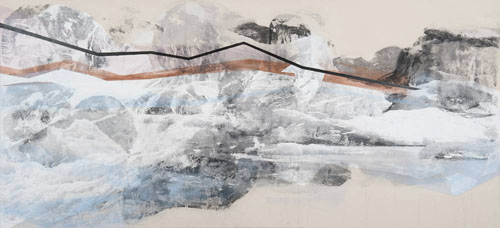“Elizabeth Blau Takes an Interesting Approach to Landscapes at Brett Wesley”
Las Vegas Weekly – Dawn Michelle Baude – May 7, 2014

Ecological narrative: “Temperature Anomaly,” part of Elizabeth Blau’s Changing Landscapes exhibit at Brett Wesley Gallery.
Changing Landscapes Through May 31; Wednesday-Friday, 1-8 p.m.; Saturday, 1-4 p.m. Brett Wesley Gallery, 433-4433.
Once upon a time, landscape painting idealized nature. Nowadays, the idea of depicting majestic mountains seems as quaint as home-ground flour. Too much is arguably at stake on planet Earth—too much evidence of destruction—to put landscape at the center of an artistic practice. But Elizabeth Blau went and did it anyway in her latest show, Changing Landscapes. Drawing from science and a spectrum of artistic technique, the 10 mixed-media paintings on exhibit at Brett Wesley Gallery transform genre painting into disarming ecological narratives.
Glaciers from the Arctic are the main subject matter in Blau’s works, but like the ice fields themselves, the imagery won’t sit still. A variety of processes—underpainting, overpainting, acrylic transfer of photos, glazing, printing, staining, drawing, etc.—collaborate in intriguing palimpsests. A crisp, hard-edged graph line extends across the paintings, literally topping the works in a bid to anchor the uncanny layering. Sourced from environmental data, the geometric graph lines contrast with the organic forms, symbolizing the man-vs.-nature conflict.
In one of the strongest pieces, “Temperature Anomaly,” the graph line dive-bombs into an icy mound, while the slopes, cliffs and plateaus of the glaciers seemingly transform in front of the eyes. The ice turns into water, into foam, froth, rock, sand and desert. It melts into the nothingness of negative space edging the mountains or river or sea. Elsewhere in the composition, it’s no longer even ice at all—it’s an expressionist gesture or an Old Master’s glaze.
The movement from photo to painting, from representational to abstract and back again, is emphasized by the panoramic format of the canvases. The elongated shapes allude to both wide-angle photography and to film. Just as the Cubists strove to depict a static object from multiple angles, Blau charts the evolution of a landscape over time, portraying an imagined geologic memory. Is that basket weave topping an ice floe? A footprint? An allusion to Lascaux? A loss of identity?
When Blau employs a more variable palette in a few pieces, the complexity of the layering tussles with the visual density of contrasting colors, so that the paintings sacrifice the texture that is the source of their power. The most convincing works in Changing Landscapes are studies in restraint, neither message-heavy with activism nor maudlin with nostalgia. The tension between control and chance in the layering literally holds the floodwaters back, producing landscapes that open into fresh, uncharted beauty.
“Where the Heart Is”
Blau focuses on home—as the roofs are caving in
by Susanne Forestieri
January 15, 2009 read article
“Iceberg Theory”
City Life, Las Vegas
January 24, 2008
(pdf file)
“Ice in the Desert”
Las Vegas Review Journal
December 28, 2007
(pdf file)
Additional Press:
“Newfangled”
Las Vegas Weekly
July 24, 2008
read article
